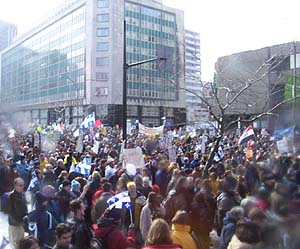Protest facts for kids
A protest is when a group of people come together. They want to show others that they strongly support or are against an idea or event. For example, people might protest against war or to support equal rights.
People protest for many reasons. They want to make their voices heard. Protests can help bring about change.
Contents
What is a Protest?
A protest is a way for people to express their feelings. It shows what they believe is right or wrong. It is a public way to share strong opinions. People often protest when they feel something needs to change. They might want new laws. Or they might want to stop something from happening.
Why Do People Protest?
People protest for many different reasons. They might want to protect the environment. They could be asking for better schools. Sometimes, people protest to support a group of people. Other times, they protest against unfair rules. They want leaders to listen to their concerns. Protesting is a way to ask for attention. It helps to highlight important issues.
How Do People Protest?
There are many ways people can protest. Most protests are peaceful. People might march in the streets. They could hold signs with messages. Sometimes, people sing songs or chant slogans. They might also write letters to leaders. Some people choose to not eat food for a cause. This is called a hunger strike. It shows how serious they are.
Peaceful Ways to Protest
- Marches and Rallies: People walk together in a group. They often carry signs. This shows their numbers and their message.
- Petitions: People sign a document. This document asks for a specific change. Many signatures show strong support.
- Boycotts: People stop buying certain products. Or they stop using certain services. This puts pressure on companies or governments.
- Sit-ins: People gather in a public place. They stay there to draw attention. This can be in a building or an area.
- Art and Music: Artists create works that share a message. Musicians write songs about important issues. This helps spread awareness.
What Happens After a Protest?
Protests can have a big impact. They can make people think differently. They can also make leaders pay attention. Sometimes, protests lead to new laws. They can also change how people are treated. Not all protests succeed right away. But they often start important conversations. They can be the first step towards big changes.
Images for kids
-
Demonstration against the president of Iran, Mahmoud Ahmadinejad, during the Rio+20 conference in Brazil, June 2012
-
Farmer land rights protest in Jakarta, Indonesia
-
Anti-nuclear Power Plant Rally on 19 September 2011 at Meiji Shrine complex in Tokyo. Sixty thousand people marched, chanting "Sayonara nuclear power" and waving banners to call on Japan's government to abandon nuclear power following the Fukushima nuclear disaster.
-
Demonstration in front of the headquarters of the Spanish National Police in Barcelona during the 2017 Catalan general strike against brutal polices during referendum
-
Demonstration in front of the MPR/DPR/DPD building in Jakarta during 2019 Indonesian protests and riots
-
Protesters against big government fill the West Lawn of the U.S. Capitol and the National Mall, 12 September 2009
-
Protester with a "Free The Bee" placard during the COVID-19 protests in Berlin on 29th of August 2020, near the Brandenburg Gate
-
March next to the Benito Juárez Hemicycle, 27 August 1968, Mexico City
-
Black bloc members spray graffiti during an Iraq War Protest in Washington, D.C.
-
Protest march in Palmerston North, New Zealand
-
Protesters outside the Oireachtas in Dublin, Republic of Ireland

















